The Gentian Market is estimated to be valued at USD 510.3 million in 2025 and is projected to reach USD 755.4 million by 2035, registering a compound annual growth rate (CAGR) of 4.0% over the forecast period.
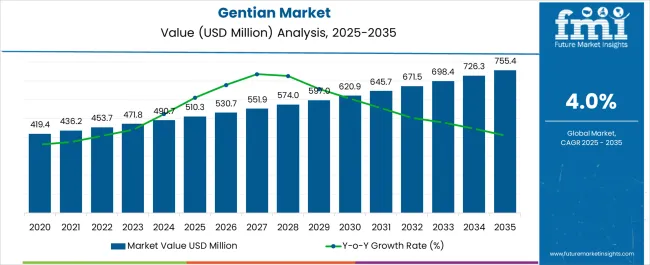
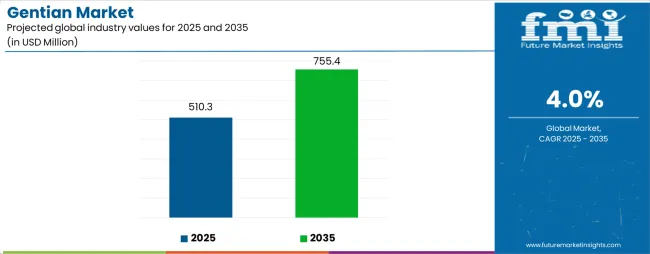
| Metric | Value |
|---|---|
| Gentian Market Estimated Value in (2025 E) | USD 510.3 million |
| Gentian Market Forecast Value in (2035 F) | USD 755.4 million |
| Forecast CAGR (2025 to 2035) | 4.0% |
The Gentian market is experiencing steady growth, driven by the increasing demand for natural herbal ingredients across pharmaceutical, nutraceutical, and health-focused industries. Organic sources are being favored due to growing consumer preference for naturally derived compounds that ensure purity, safety, and sustainability. The market is further supported by the expanding adoption of Gentian in therapeutic formulations, digestive aids, and dietary supplements.
Advances in cultivation practices, extraction technologies, and quality control measures have enhanced consistency, potency, and yield, improving overall market availability. Regulatory encouragement for natural and plant-based ingredients, alongside rising awareness regarding health benefits, is contributing to adoption across global markets. Investments in research and development to explore additional applications and improve bioactive compound content are further shaping the market landscape.
With increasing integration into pharmaceutical and wellness products, coupled with a preference for organic sources, the Gentian market is poised for sustained growth Future expansion is expected to be driven by rising healthcare awareness, growing functional food and supplement demand, and the pursuit of natural, high-quality ingredients.
The gentian market is segmented by source, form, application, distribution channel, and geographic regions. By source, gentian market is divided into Organic and Conventional. In terms of form, gentian market is classified into Powder, Capsule, and Liquid. Based on application, gentian market is segmented into Pharmaceutical Industry, Cosmetic, and Food And Beverage. By distribution channel, gentian market is segmented into Store Based Retail, Specialty Stores, Online Retail, Supermarkets, and Hypermarkets. Regionally, the gentian industry is classified into North America, Latin America, Western Europe, Eastern Europe, Balkan & Baltic Countries, Russia & Belarus, Central Asia, East Asia, South Asia & Pacific, and the Middle East & Africa.

The organic source segment is projected to hold 55.4% of the market revenue in 2025, establishing it as the leading source type. Growth in this segment is being driven by consumer demand for naturally derived ingredients that offer higher purity and sustainability compared with conventional cultivation methods. Organic Gentian is preferred in pharmaceutical and nutraceutical formulations due to its consistent quality, safety, and efficacy.
Adoption is further strengthened by regulatory support and certification programs that ensure authenticity and compliance. Technological advancements in organic cultivation and extraction methods have improved yield and active compound content, making it commercially viable for large-scale production.
The increasing focus on health-conscious consumers and the global trend toward clean-label products have reinforced the preference for organic Gentian As awareness regarding the benefits of organic herbal ingredients continues to rise, the organic source segment is expected to maintain its leading position, driven by strong demand across pharmaceuticals, dietary supplements, and functional health products.
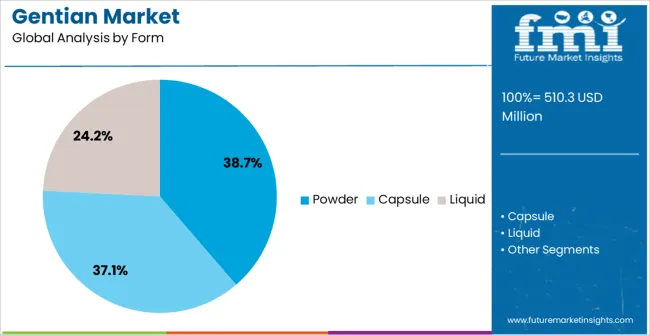
The powder form segment is expected to account for 38.7% of the market revenue in 2025, making it the leading form type. Growth is being driven by the ease of use, dosing flexibility, and incorporation into a variety of formulations, including tablets, capsules, and functional beverages. Powdered Gentian allows for precise measurement, uniform distribution in mixtures, and extended shelf life, which enhances its appeal among manufacturers and formulators.
The ability to retain bioactive compounds during processing further strengthens its adoption. The powder form is particularly suitable for pharmaceutical and nutraceutical applications, enabling efficient integration into therapeutic and health-focused products. Advancements in drying, milling, and preservation technologies have improved quality and consistency, ensuring reliable performance in end products.
Increasing demand for convenient and versatile herbal ingredients continues to drive the adoption of the powder form As manufacturers focus on product innovation and standardized formulations, the powder segment is expected to remain the preferred form type, supporting overall market growth.
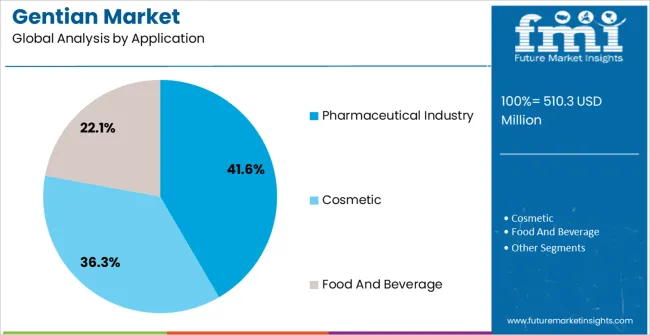
The pharmaceutical industry application segment is anticipated to hold 41.6% of the market revenue in 2025, making it the leading application. Growth is being driven by the use of Gentian in digestive aids, tonics, and herbal therapeutic formulations that benefit from its bioactive properties. Pharmaceutical manufacturers are increasingly incorporating Gentian to enhance product efficacy, meet consumer preference for natural ingredients, and comply with regulatory standards for herbal medicines.
The ability to integrate Gentian into capsules, tablets, and functional formulations without compromising bioactive compound stability has strengthened adoption. Rising demand for herbal and plant-based remedies, alongside a focus on preventive healthcare, is further propelling the segment.
Investments in research to validate therapeutic benefits, improve extraction efficiency, and standardize formulations have enhanced its credibility within pharmaceutical applications As healthcare providers and consumers continue to favor plant-based and natural medicinal solutions, the pharmaceutical industry segment is expected to remain the primary driver of market growth, supported by innovation and regulatory acceptance.
According to research by Future Market Insights, The Gentian market is anticipated to expand at a CAGR of 4.00% during the forecasted period. According to Forecasts, the market would be worth US$ 532.4 Million by 2035, up from US$ 471.8 Million in 2025.
| Attributes | Details |
|---|---|
| Market size value in 2025 | US$ 471.8 Million |
| Market forecast value in 2035 | US$ 532.4 Million |
| Forecast period | 2025 to 2035 |
| Global growth rate (CAGR) | 4.00% |
| Share of Germany in The Gentian Market | 28.90% |
Gentian is a high-altitude plant found mostly in the Alps and Himalayas. Gentian is a flowering plant that belongs to the gentian family, specifically the tribe Gentianeae. Gentians are known for their big, trumpet-shaped blooms that are frequently a deep blue hue.
Some species of Gentian may also be found in northern Africa, eastern Australia, and New Zealand. It takes 7 to 10 growing seasons for the Gentian root to develop. And its roots have widespread application in a variety of sectors.
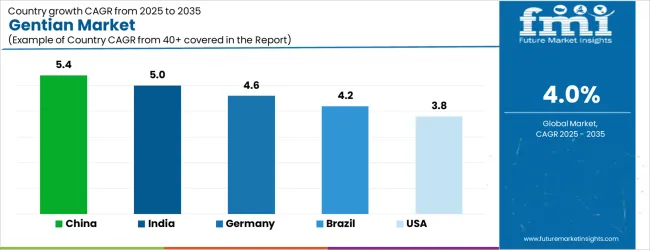
| Country | CAGR |
|---|---|
| China | 5.4% |
| India | 5.0% |
| Germany | 4.6% |
| Brazil | 4.2% |
| USA | 3.8% |
| UK | 3.4% |
| Japan | 3.0% |
The Gentian Market is expected to register a CAGR of 4.0% during the forecast period, exhibiting varied country level momentum. China leads with the highest CAGR of 5.4%, followed by India at 5.0%. Developed markets such as Germany, France, and the UK continue to expand steadily, while the USA is likely to grow at consistent rates. Japan posts the lowest CAGR at 3.0%, yet still underscores a broadly positive trajectory for the global Gentian Market.
In 2024, Germany held a dominant revenue in the Western Europe market and is expected to grow with a CAGR of 4.6%. The USA Gentian Market is estimated to be valued at USD 186.2 million in 2025 and is anticipated to reach a valuation of USD 186.2 million by 2035. Sales are projected to rise at a CAGR of 0.0% over the forecast period between 2025 and 2035. While Japan and South Korea markets are estimated to be valued at USD 27.9 million and USD 15.4 million respectively in 2025.
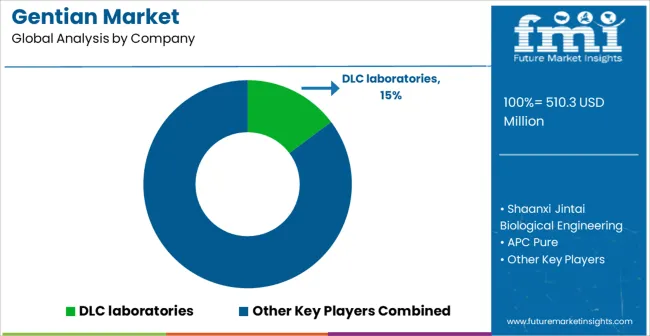
| Item | Value |
|---|---|
| Quantitative Units | USD 510.3 Million |
| Source | Organic and Conventional |
| Form | Powder, Capsule, and Liquid |
| Application | Pharmaceutical Industry, Cosmetic, and Food And Beverage |
| Distribution Channel | Store Based Retail, Specialty Stores, Online Retail, Supermarkets, and Hypermarkets |
| Regions Covered | North America, Europe, Asia-Pacific, Latin America, Middle East & Africa |
| Country Covered | United States, Canada, Germany, France, United Kingdom, China, Japan, India, Brazil, South Africa |
| Key Companies Profiled | DLC laboratories, Shaanxi Jintai Biological Engineering, APC Pure, Nature’s Answer, Changsha Vigorous-Tech, Swanson Health Products, Sichuan Xiaoye Bencao Biotechnology, Vital Nutrients, Bell’s Healthcare, The Bach Centre, Shaanxi Undersun Biomedtech, Xi'an DN Biology, and Bio-Botanica |
The global gentian market is estimated to be valued at USD 510.3 million in 2025.
The market size for the gentian market is projected to reach USD 755.4 million by 2035.
The gentian market is expected to grow at a 4.0% CAGR between 2025 and 2035.
The key product types in gentian market are organic and conventional.
In terms of form, powder segment to command 38.7% share in the gentian market in 2025.






Our Research Products

The "Full Research Suite" delivers actionable market intel, deep dives on markets or technologies, so clients act faster, cut risk, and unlock growth.

The Leaderboard benchmarks and ranks top vendors, classifying them as Established Leaders, Leading Challengers, or Disruptors & Challengers.

Locates where complements amplify value and substitutes erode it, forecasting net impact by horizon

We deliver granular, decision-grade intel: market sizing, 5-year forecasts, pricing, adoption, usage, revenue, and operational KPIs—plus competitor tracking, regulation, and value chains—across 60 countries broadly.

Spot the shifts before they hit your P&L. We track inflection points, adoption curves, pricing moves, and ecosystem plays to show where demand is heading, why it is changing, and what to do next across high-growth markets and disruptive tech

Real-time reads of user behavior. We track shifting priorities, perceptions of today’s and next-gen services, and provider experience, then pace how fast tech moves from trial to adoption, blending buyer, consumer, and channel inputs with social signals (#WhySwitch, #UX).

Partner with our analyst team to build a custom report designed around your business priorities. From analysing market trends to assessing competitors or crafting bespoke datasets, we tailor insights to your needs.
Supplier Intelligence
Discovery & Profiling
Capacity & Footprint
Performance & Risk
Compliance & Governance
Commercial Readiness
Who Supplies Whom
Scorecards & Shortlists
Playbooks & Docs
Category Intelligence
Definition & Scope
Demand & Use Cases
Cost Drivers
Market Structure
Supply Chain Map
Trade & Policy
Operating Norms
Deliverables
Buyer Intelligence
Account Basics
Spend & Scope
Procurement Model
Vendor Requirements
Terms & Policies
Entry Strategy
Pain Points & Triggers
Outputs
Pricing Analysis
Benchmarks
Trends
Should-Cost
Indexation
Landed Cost
Commercial Terms
Deliverables
Brand Analysis
Positioning & Value Prop
Share & Presence
Customer Evidence
Go-to-Market
Digital & Reputation
Compliance & Trust
KPIs & Gaps
Outputs
Full Research Suite comprises of:
Market outlook & trends analysis
Interviews & case studies
Strategic recommendations
Vendor profiles & capabilities analysis
5-year forecasts
8 regions and 60+ country-level data splits
Market segment data splits
12 months of continuous data updates
DELIVERED AS:
PDF EXCEL ONLINE

Thank you!
You will receive an email from our Business Development Manager. Please be sure to check your SPAM/JUNK folder too.
Chat With
MaRIA